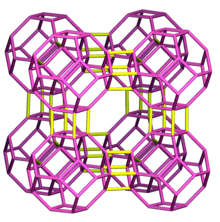
Back Molekulêre sif Afrikaans منخل جزيئي Arabic Малекулярныя сіты Byelorussian Tamís molecular Catalan Molekularsieb German Tamiz molecular Spanish غربال مولکولی Persian Molekyyliseula Finnish Tamis moléculaire French מסננת מולקולרית HE


A molecular sieve is a material with pores of uniform size. These pore diameters are similar in size to small molecules, and thus large molecules cannot enter or be adsorbed, while smaller molecules can. As a mixture of molecules migrates through the stationary bed of porous, semi-solid substance referred to as a sieve (or matrix), the components of the highest molecular weight (which are unable to pass into the molecular pores) leave the bed first, followed by successively smaller molecules. Some molecular sieves are used in size-exclusion chromatography, a separation technique that sorts molecules based on their size. Another important use is as a desiccant. Most of molecular sieves are aluminosilicate zeolites with Si/Al molar ratio less than 2, but there are also examples of activated charcoal and silica gel.[1]
The pore diameter of a molecular sieve is measured in ångströms (Å) or nanometres (nm). According to IUPAC notation, microporous materials have pore diameters of less than 2 nm (20 Å) and macroporous materials have pore diameters of greater than 50 nm (500 Å); the mesoporous category thus lies in the middle with pore diameters between 2 and 50 nm (20–500 Å).[2]
- ^ "Molecular Sieve Definition - Definition of Molecular Sieve - What Is a Molecular Sieve?". Chemistry.about.com. 2013-12-18. Archived from the original on 2014-02-21. Retrieved 2014-02-26.
- ^ J. Rouquerol; et al. (1994). "Recommendations for the characterization of porous solids (Technical Report)" (free download pdf). Pure Appl. Chem. 66 (8): 1739–1758. doi:10.1351/pac199466081739. S2CID 18789898.
© MMXXIII Rich X Search. We shall prevail. All rights reserved. Rich X Search